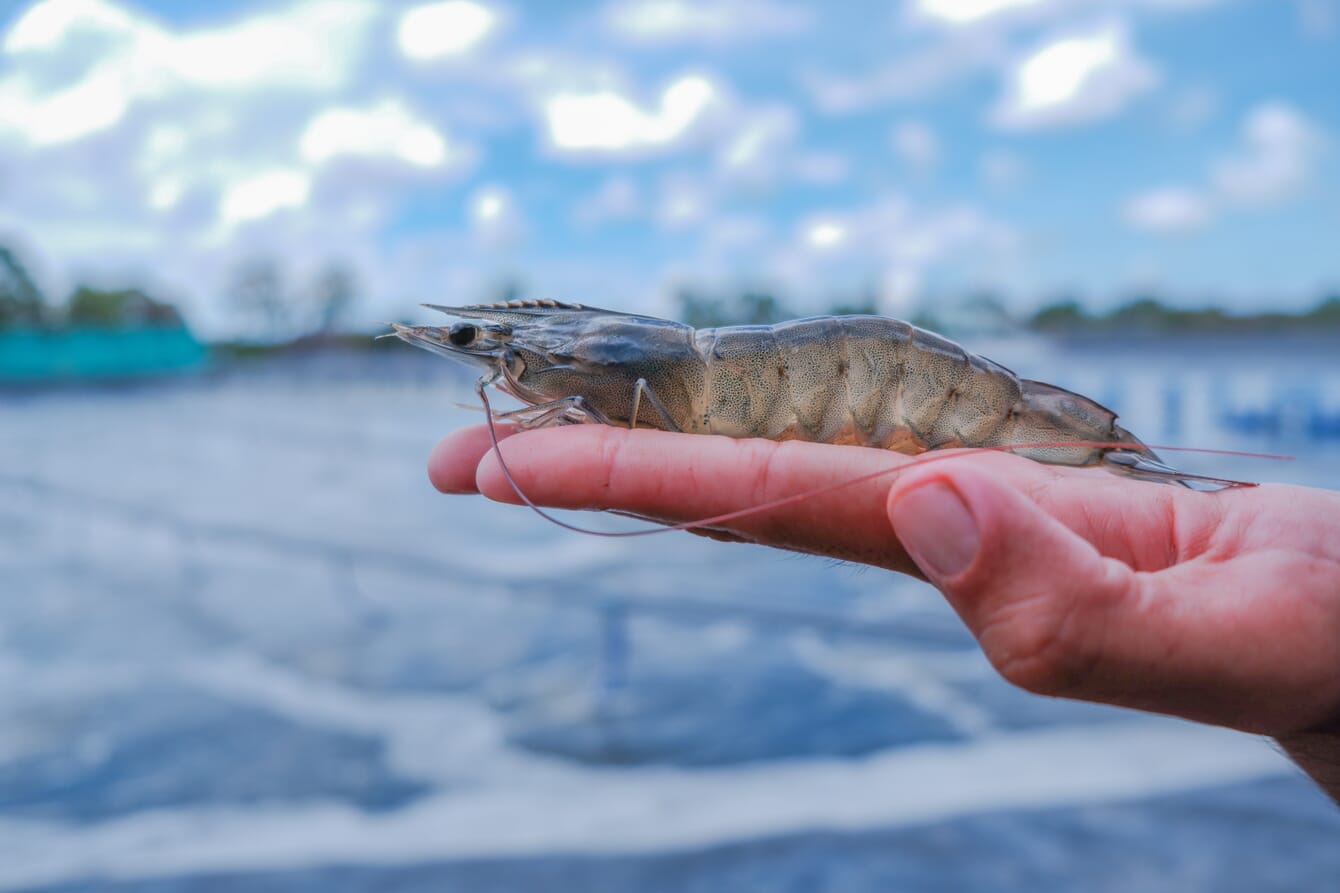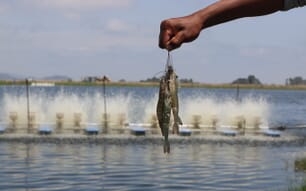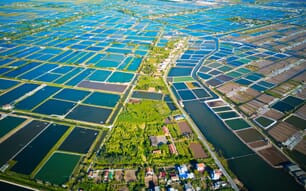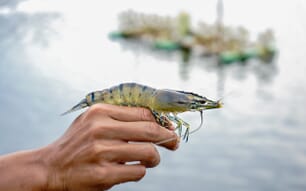
Europe is not the largest market for shrimp, accounting for 11 percent of the global share, but it is certainly an interesting one that Kontali’s trade and market model can provide deep insights into. As it includes over 10 species – across farmed and wild-caught – we will focus on the most relevant ones.
Around 30 percent of the shrimp consumed in Europe comes from local production (mostly fisheries), and the other 70 percent is dependent on imports. Sixty percent of the total is from farms.
But it’s necessary to look beyond the trade data on warm water shrimp imports to get the full picture. These additional shrimp, caught locally or imported, sometimes compete with warm water shrimp, such as vannamei, but often also serve their own niche markets.
Vannamei dominate the European market. While the Covid-19 pandemic caused some disrupted trade flows, pushing down the volume, it steadily recovered during 2021 and 2022, when importers focused on securing products and market demand was expected to be up again. However, due to the sluggish market demand in 2022 and the large existing inventory, the supply to market during 2023 decreased by 10 percent, to just under 450,000 tonnes live shrimp equivalent (LSE).
Argentine red shrimp is valued for its quality, especially when it is head on, shell on (HOSO). Despite its reputation, it faces stiff competition in the European market, particularly from vannamei, which is known for its affordability. Some industry players have resorted to processing Argentine red shrimp in third countries in a bid to lower costs and enhance competitiveness and it has consolidated its position in the southern European market as well as gaining some headway in the northwestern European market over the last few years. Overall European demand during 2022 and 2023 has remained stable, at around 80,000 tonnes LSE.
Another species that has seen its market share decline in Europe over the last decade is the black tiger shrimp (P. monodon). This change is primarily due to the increased availability of more economical vannamei, but another contributing factor is the consumer demand for certified sustainable seafood, which not all black tiger products can meet. As such, black tiger shrimp currently serves a niche in the food service and retail markets. While the Covid-inspired slowdown in food service reduced demand for black tiger shrimp in 2020 and 2021, an uptick was seen in 2022, reaching almost 40,000 tonnes again. However, this subsided to around 30,000 tonnes during 2023 due to the large backlogs of stockpiled inventory that hadn’t been used up.
Niche shrimp species
While the above-mentioned species are often reported on, there are also some lesser known shrimp which still have a relatively high market share. These include the deep water rose shrimp, a large shrimp mainly caught in the Mediterranean, which serves medium- to high-end markets in southern Europe (especially Italy, Spain, and Greece), with a total market size in Europe of around 30,000 tonnes LSE.
Atlantic seabob has a smaller market share in Europe, around 1,500 tonnes LSE during 2023, marking a 40 percent drop from 2022. They are mainly used as a salad shrimp in the ready-meal market and as peeled and cooked refreshed chilled products in retail in Germany, the Netherlands, and Belgium.
The European shrimp market is rather fragmented, and shrimp are also traded between European countries, making specific trade flows difficult to follow. However, based on consumer preferences, Europe can be broadly divided into northwestern, southern and eastern regions, while the UK has it’s own trends.
According to a study by the European Commission, shrimp account for 6 percent – about 1.5 kg per person – of total European seafood consumption. However, the variation between countries is significant, with Spain leading at over 3 kg and the Netherlands at the low end at 600 g.
With a large variety of tastes, places to purchase shrimp, and routes to markets, Europe hosts a wide range of seafood and fish importers. These range from organisations that buy for large retail and trade up to 20,000 tonnes per year, to wholesalers who buy only two or three containers per year. Within retail and industry, those importers who reprocess for the refreshed segment are bigger than those who only do business in the frozen segment. This is mainly because reprocessing frozen shrimp products into chilled products and to package these products for retail distribution requires significant investments in processing facilities and logistics.
On the industrial side, it is worth mentioning specialised shrimp processors. They further add value in a number of ways, ranging from simple repacking, to glazing and repacking, to cooking (or blanching) and freezing and glazing and packing. They typically also have a chilled (mainly under MAP) distribution channel. The most wanted product for this segment is small peeled deviened and peeled undeviened vannamei shrimp. Most of these processors are in Northwestern Europe. This type of industry is under attack from importers/retailers who make use of lower labour costs at the source. Key players in this segment are Heiploeg, Dutch Seafood Company and Shore.
The second type of specialised shrimp processor is found in southern Europe: industrial companies that cook HOSO shrimp and sell chilled shrimp for all kinds of end-users (retail, fishmongers, food service, etc.) This has become a particularly big market in France and is of significant interest to vannamei suppliers from around the world (“Le cuite du jour” = daily cooked). Key players in this segment are Delpierre (Groupe Labeyrie), Krustanord France (Pescanova Group), Pescanova Spain, Gambafresh and Crusta C (France). In terms of suppliers, these companies look for larger volumes of cheap HOSO vannamei that preferably has a A3/A4 (ie red) colour, while sometimes A2 is also accepted. Most of their shrimp is now sustainably certified, especially for the retail market. They do still buy non-certified shrimp, but only for food service, or distribution via fishmongers.
It is difficult to provide an estimate of the level of consolidation in the European market. A rough estimate is that Europe’s top 20 shrimp importers have a 20-30 percent market share. However, this varies a lot between specific market segments. In the Northwestern European refreshed retail market (Germany, Netherlands, Belgium) we estimate that the top three players (Heiploeg, Dutch Seafood Company and Shore) have at least 60 to 70 percent market share. Similarly, the Spanish and French market for cooked HOSO is also rather concentrated, with the top five processors most likely occupying around 60 percent market share as well. In the frozen segment of Europe’s retail and institutional foodservice market, many more players are active, while the fragmentation among Europe’s importers for the wholesale restaurant segment is even bigger. In this segment, the biggest 10 importers would not even have a 30-40 percent market share.
Northwestern Europe
Northwestern Europe is an important trade hub and features major re-processors for the wholesale and retail industry. Germany, the Netherlands and Belgium all have large ports with Rotterdam in the Netherlands, Hamburg in Germany, and Antwerp in Belgium. A significant share of the imported volume of seafood (warmwater shrimp) is processed in these countries before being shipped on to other European countries
The Benelux market consumes a large quantity of common shrimp (Crangon crangon) in addition to vannamei and northern shrimp. Although locally caught shrimp make some Northwestern consumers familiar with shrimp for home cooking, the majority of consumers prefer ready-to-cook convenience products. These peeled and value-added products can be found in retail, both as frozen and refreshed products. The species offered in retail are usually Pacific white shrimp, or for ready-to-eat meals, cold water shrimps are used. While this market holds a good market share, being price competitive is key and sustainability certification is needed.
Most of the black tiger shrimp brought into these markets are sold in the wholesale market, where they're considered a high-end alternative to Pacific white shrimp. As the prices of Pacific white shrimp drop, wholesalers who sell a wide range of products are more likely to choose it over black tiger shrimp if they're available in the same sizes. However, black tiger shrimp remains a popular choice for sizes larger than 26–31 pieces per kilogram, where Pacific white shrimp might not be as easy to find.
In Europe's Asian wholesale markets, black tiger shrimp holds a strong position compared to the broader wholesale market. Asian restaurants often prefer black tiger shrimp and are less willing to switch to the cheaper Pacific white shrimp.
The UK market
Within Northwestern Europe, the UK needs to be considered as a different market. While Brexit has had a hand in this, in general the consumption of shrimp – especially northern prawn – is much higher than in the rest of the region, at almost 1.7 kg per person. Both coldwater and warm water shrimp are consumed as parts of salads, pasta and pizza, but rarely as the meal’s main ingredient. Next to that, the UK hosts a high ethnic diversity, whereby seafood consumption is more common. Between 2019 and 2023, the import of shrimp has shown a CAGR of 6 percent for all shrimp species. However, whiteleg shrimp has shown a growth of 13 percent, whereas the demand for northern prawns reduced by 7 percent
In the UK, more than 60 percent of shrimp are sold in retail, however, there is a distinction between cold water shrimp and warm water shrimp. For cold water shrimp, around 80 percent are sold through retail, while for warm water shrimp the proportion is only 50 percent.
In the UK's Asian market, it's typical to find black tiger shrimp sold in different forms, often under brands owned by exporters from Bangladesh, and occasionally from India. Several British Asian wholesalers even have their shrimp processing facilities located in Bangladesh. Some of these companies import shrimp from Bangladesh, process it in the UK, and then market it as refreshed products. Meanwhile, other importers bring in finished products and sell them as is.
Southern Europe
The market of southern Europe consists of Spain, Portugal, Italy and France. This region is much more focused on the consumption of (fresh) seafood in general than the northwestern region. Moreover, quality requirements such as colour, size and freshness are more important. Roughly speaking, the main shrimp product is HOSO, as the countries around the Mediterranean have a large number of recipes based on these. However, because these countries also have the highest per capita seafood consumption, the volume of peeled shrimp is also big. Most shrimp in the south will be raw (or blanched) as people still cook dinners from scratch. A special mention for cooked HOSO (cooked in Europe). This has become a convenience product in the Mediterranean markets, with a special interest in “brine frozen” shrimp – a technique, which freezes the product deeper and faster, thereby reducing the risk of melanosis, and enhancing the overall quality of the shrimp. Especially in France, the colour will get a premium of up to 20 percent.
Overview of shrimp demand
Overall, consumers in southern Europe largely buy shrimp in supermarkets, fishmongers, and specialty shops. A large driver here is the cooked (re-)fresh market, where people aim to buy fresh products. Frozen products end up in the food service industry more, allowing restaurants to have the ability to defrost what is needed. Furthermore, most high-end restaurants prefer to use local wild-caught shrimp, such as deep-water rose shrimp.
Shrimp prices
The dynamics of shrimp pricing in the European market are influenced by various factors, with farmed shrimp playing a significant role. As the supply of farmed shrimp, like vannamei, continues to increase year on year, it impacts the pricing of wild-caught shrimp. This trend is particularly evident in Europe, where imported warm-water shrimp have seen a consistent decrease in prices due to higher volumes and advances in processing techniques.
A study conducted by the University of Copenhagen in 2017 highlighted the significant influence of warm water shrimp on the European market. It suggested that, while the coldwater shrimp sector may remain relatively protected in the short term, there's a potential for a shift in consumer preferences towards warm water species in the long run. This shift could ultimately affect the pricing dynamics, with coldwater shrimp prices being influenced by the demand and supply of warm-water shrimp, which is significantly larger.
Comparing prices across different origins, product forms, and presentations poses challenges in this complex market environment. For instance, the prices of Argentine red shrimp and vannamei shrimp are closely linked, especially over longer-term cycles. Understanding these interconnections is crucial for stakeholders to navigate the intricacies of the shrimp market and make informed decisions.
Outlook for European market demand
Inventory is at a healthier level, and seafood prices are becoming more accessible again due to the positive inflation trend for fish and seafood. The inflation rate dropped by 0.9 to 2.3 percent between February and March. An even more substantial reduction in inflation was observed for frozen seafood, reaching a 1.2 per cent point drop and at -0.6 percent in March. Therefore, the demand for frozen shrimp during Q1 2024 seems to have been better than in 2023, with an estimated 11 percent YoY growth in volume for Vannamei, reaching 85,000 tonnes LSE. Imports from Ecuador during January and February are estimated to be 14,700 and 13,500 tonnes, respectively, and show a positive uptick in March to 14,800 tonnes LSE. Supply from India remains relatively steady at just over 5,000 tonnes LSE. But imports from Vietnam gradually decreased during Q1 to just under 3,000 tonnes LSE in March but are estimated to increase again in May to 4,600 tonnes LSE.
The impact of geopolitics
The hijacking of commercial ships and drone attacks carried out by Iran-backed Houthi rebels still affects the export route from Asia to Europe and continues to disrupt supply chains. According to the Shanghai Freight Index, transport costs peaked in mid-January. While costs came down slightly in February, they are still about three times higher than before the attacks. Although there does not seem to be an immediate inventory strain, many have pushed more products into the market by selling shrimp at lower prices, and as a result, inventory has reportedly come down for a large share of importers. Therefore, delays in delivery times might result in European importers considering other origins for their orders. Alternatively, we might see more European companies trying to renegotiate their deals at the origin to compensate for reduced margins due to the higher logistics costs.
Conclusions and outlook
In conclusion, the outlook for the European market demand for shrimp presents both opportunities and challenges. With an expected compound annual growth rate (CAGR) of around 7 percent in the years to come, there is a promising trajectory for the industry. However, certain factors – such as the declining catches of local species in Europe and measures on CO2 emissions – pose challenges.
A significant trend is the shift towards more convenient product forms, particularly in northwestern Europe, where large market players and processors are driving the demand for value-added shrimp products. This shift might enable a greater market penetration for shrimp, despite the reduction in local production.
While southern Europe remains a dominant force in shrimp demand, the pricing dynamics, especially for vannamei shrimp, will play a crucial role in determining market dynamics. If prices for vannamei continue to decrease at the consumer level over the coming years, there's a likelihood that other shrimp species will struggle to retain their market share.
Similar to what has occurred in northwestern Europe, it's anticipated that vannamei shrimp will push out other products to niche markets, as occurred with black tiger shrimp. This trend highlights the importance of adapting to changing market dynamics and innovating product offerings to remain competitive in the European shrimp market.








